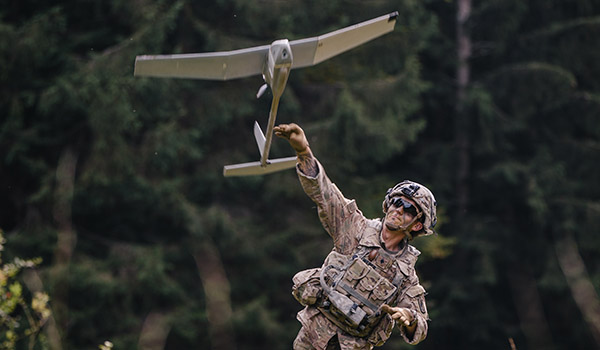
PM UAS / By COL Scott Anderson: In December 2018, Training and Doctrine Command (TRADOC) released TRADOC Pamphlet 525-3-1, “The U.S. Army in Multi-Domain Operations 2028.” This document serves as the first step in the doctrinal evolution for future operations of the Army of 2028 across all warfighting domains – air, land, sea, space, and cyber. It provides a foundation for continued discussion, analysis, and development of our warfighting methods to comprehend enabling the joint force on the future battlefield. This evolution of comprehension and understanding will guide organizational change, as well as inform decisions about future operational changes and commitment of resources for Army modernization efforts.

SPC Trever Weber, a U.S. Army paratrooper assigned to the 1st Battalion, 503rd Infantry Regiment, 173rd Airborne Brigade, throws a small unmanned aircraft system (SUAS) Raven into flight prior to expected enemy contact in Hohenfels Training Area, Germany, during Saber Junction 19 (SJ19), Sept. 22, 2019. / U.S. ARMY PHOTO BY SPC RYAN LUCAS, 173RD AIRBORNE BRIGADE
The Multi-Domain Operations (MDO) concept departs from the Army Force 2025 concept, which focused on operating with a much leaner force. The new guidance shifts the emphasis from counter-insurgency operations (COIN) to threats from near peer and great power adversaries. China and Russia have committed immense capital to the development and deployment of widespread Anti Access/Area Denial (A2/AD) systems. Arrayed in layers, these systems create immense standoff ranges to attempt to deny U.S. forces the ability to gather intelligence and to maneuver uncontested as in past conflicts.
Our enemies have and will continue to develop and improve A2/AD systems; including conventional forces, air defenses, long-range fires, disruptions to communications, and denial of navigation timing. To defeat these multiple layers of standoff, we must leverage the joint force across multiple domains. The breadth and depth of these threat effects could render our forces to limited windows of uncontested maneuver.
As a result, the MDO concept envisions Army formations (operating as part of the Joint Force) penetrating and disintegrating enemy A2/AD systems; exploiting the resulting freedom of maneuver to defeat the enemy and achieve our objectives; and consolidating gain to return to competition on terms more favorable to the U.S., our allies, and our partners.Unmanned aircraft systems (UAS) are critical to overcoming our enemies’ attempt to create standoff, to enabling our ability to penetrate and dis-integrate the enemy’s A2/AD systems, and to exploiting the windows of supremacy to maneuver our forces.
Our Mission
Creating an MDO capable force by 2028 requires utilizing all available acquisition initiatives and strategies. We must focus on our core competency – Design, Develop, Deliver. We should challenge existing timelines for requirements development, acquisition, materiel development, and production to initiate and execute capability delivery by 2028.
When envisioning the MDO capable force of 2028, and the MDO ready force of 2035, one of our key responsibilities is to clearly understand and communicate Army priorities to the UAS community and its stakeholders at every critical juncture.
We must maintain our current readiness and support the Soldier, prepared to “fight tonight” with our current platforms. We must bridge gaps and identify key capabilities required in 2028 to enable the MDO capable force, and we must attain overmatch and provide an MDO ready force in 2035.
PM UAS must attain improvements to survivability and address critical capability improvements to reach, protection, and lethality. Essential to the successful delivery of MDO 2028 capability is the implementation of cross-cutting, technology enablers; such as Assured Position, Navigation, and Timing (A-PNT), networks, payloads (sensors / weapons), autonomy, and distributed control. Ultimately, PM UAS will incorporate these technologies, resulting in affordable, producible, reliable, sustainable, and highly integrated platform capabilities.
Simultaneously, we must work across all stakeholders to formulate the UAS Strategy for an MDO ready force of 2035. PM UAS will continue to engage industry about current capabilities while conducting demonstrations to assess those capabilities, while monitoring S&T efforts to capture mature technology insertions. These efforts are essential to informing requirements, developing successful acquisition strategies, and ultimately delivering timely capability to the Soldier.
The fundamental capabilities provided by Army Aviation are reconnaissance and security, air assault and air movement, and attack. These capabilities do not change under MDO but become more complex and more difficult to deliver. Currently, PM UAS fields and supports the reconnaissance, security and attack core Army Aviation capabilities.
In the future, that role could expand into the Aviation capability of air movement. In support of MDO, UAS could serve as the last mile for precision logistics to provide rapid and agile sustainment from strategic support areas to the deep maneuver area, further removing the Soldier from harm’s way.
By understanding the current UAS technologies and examining all aspects of our warfighting methods and how those technologies and methods are challenged in the future by near-peer and great power adversaries, the PM UAS team is well-equipped to challenge assumptions and understand how to create the systems required to excel in Multi-Doman Operations. Team UAS will design, develop, deliver and support ready and lethal unmanned systems to ensure America’s Army is prepared to succeed in any domain, anytime, anywhere.
COL Scott Anderson is the project manager for Unmanned Aircraft Systems assigned to the Program Executive Office, Aviation at Redstone Arsenal, AL.










